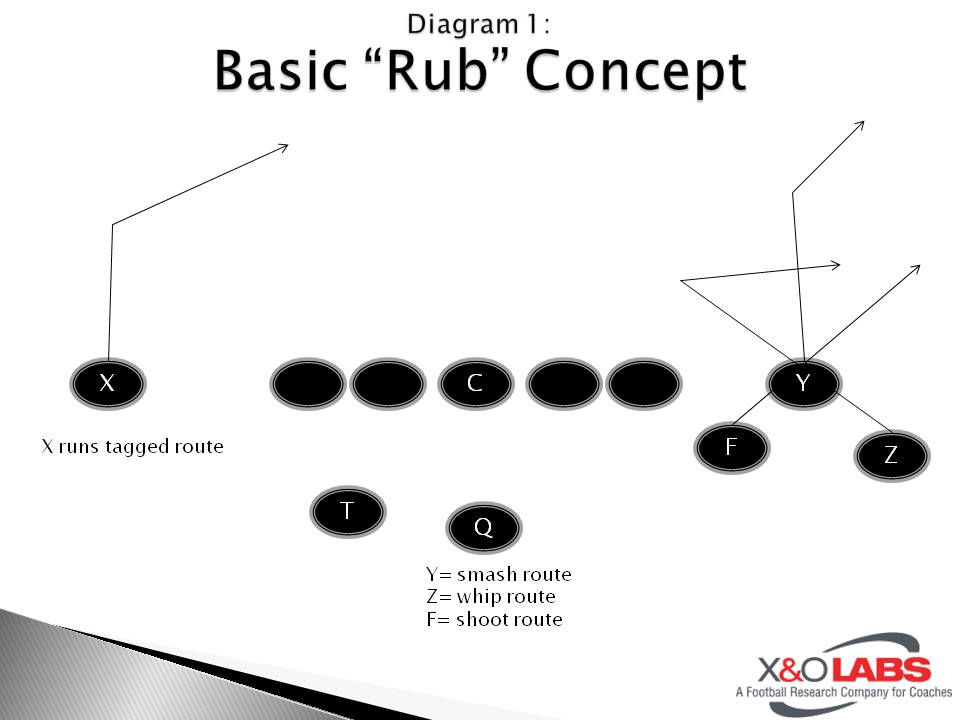Variations of the "Rub," the Most Popular Pass Concept in Compressed Formations
By Mike Kuchar Senior Research Manager X&O Labs
Researchers' Note: You can access the raw data - in the form of graphs - from our research on the bunch rub/compressed formations: Click here for the Statistical Analysis Report.
X&O Labs originally designed our latest research report on using compressed (tight) formations to take advantage of defenses. But, once we started to compile our results, we found an abundance of coaches that wanted to learn more about "bunch" formations, where three receivers are stacked within three yards or less of each other. While the formation structure has been around since the days of the Bill Walsh era in San Francisco in the early 1980’s, perhaps the bunch formation didn’t trickle down to lower levels until high school coach, Andrew Coverdale (Trinity, LA), detailed in his book The Bunch Passing Attack (read more about this book here)
Before we get into the nuances of the bunch schemes, we just wanted to recap some of the reasons our coaches had for using the bunch formation. While it may be a "spread" scheme in nature, 42.6 percent of coaches will utilize bunch out of 10 personnel, more than any other personnel grouping. It’s important to note, bunch concepts can be delegated to any personnel grouping. In fact, schools like Boise State have found ways to use the same concepts out of 21 personnel and still be effective.
Advantages of running the bunch:
- Creates Space: Talk to any offensive coordinator and he will tell you this is the biggest factor in running the bunch scheme. Over 30 years ago, Tubby Raymond said the quickest way to get to flank (perimeter) is to shorten the edge. And he was the master of the Wing T. It’s still effective today.
- Makes Defenses Declare: Since this is a non-traditional set, defenses will need to adjust. Some will check to a man concept, while some will roll to zone coverage. Either way, you’ll know how they’re playing it. If you see a safety roll to the bunch, it’s some form of single high (cover three or cover one) and if that corner widens to stay in the flat (it’s some form of cover two). In any case it doesn’t matter, because as Coverdale states in his book, there is an answer for everything.
- Productive Against Any Coverage: Because the bunch passing concepts have elements of a zone and man beater already designed (as we will detail later in the report) you’ll see that once a QB recognizes the coverage, he’ll know where to go with the ball.
- Defenses Get Uncomfortable: A bunch scheme changes the picture for a defense. It changes the environment in terms of angles that coverage players need to break and how to leverage offensive players. There in a position of space that they are not familiar with.
- Causes Match-Up Problems: Our research staff feels this is the biggest advantage of running bunch, because you can put your best receiver anywhere. We tried to get a beat on where coaches will place their best receiver, but our research didn’t find a pattern. Some coaches liked to put their best receiver as the point man in bunch (the number two receiver) while some preferred to line him up as the inside receiver. Some coaches chose to use their best receiver at the X spot, the player away from bunch, because of a possible defensive coverage overload. In any case, one common thought process was discovered among the coaches we spoke with: decide what coverage defenses are playing to defend bunch and line your best receiver up where their deficiency is (we explain this below).
Case 1: The "Original" Mesh Concept In this report we will focus solely on one of Coverdale’s original designs, the "mesh" or "rub" concept (Diagram 1) and how various coaches have found ways to tinker with it. We’ve found that 38.2 percent of coaches use this rub concept more than any other pass concept in bunch.

The original route progression is as follows:
- PS#1 (outside receiver): Whip route, start in and break out
- PS#2 (point man): 10 yard corner route
- PS#3- (inside receiver): Flat route or shoot route
- BS #1 (back-side receiver): Tagged route; could be vertical, slant, hitch or post depending on coverage
When Coverdale first designed this concept, the primary throw was the flat or shoot route. He would change the QB’s launch points continuously, from play-action to sprint out to plain ole three-step drop. "Against zone coverage, if the defender didn’t align himself outside of the bunch and play with leverage he might be outflanked by the flat so we went there," said Coverdale in a recent online interview. But against man coverage, the whip was the more viable option. "It was very difficult for defenders to fight through traffic and play that route," said Coverdale. "Finally, if teams played some form of cover two, you had the built-in corner route over the top."
So, quite frankly where you place your best receiver could be dictated on the following:
- Vs. Cover 2: Number two man running the corner route
- Vs. Cover 3: Number one man running the flat route
- Vs. Man coverage: Number three man running the whip route
- Vs. Coverage shift or overload to bunch side: Iso the back-side X on a tag route
Now, we realize that defensive coaches get paychecks too, and X&O Labs will detail how these coordinators defend bunch in an upcoming report, so there may have to be other adjustments that offensive coaches make. Our goal in this report is to provide offensive coaches with answers, so that they can be decisive and effective, when running their bunch package.

Case 2: Attacking Cover Two: Variations of the Smash Concept This shows how easy it is for an offense to dictate to the defense where the match-up problem is, and where an offense can displace its best receiver. As Phil Longo, at Division II Slippery Rock University says, "We won’t even practice it against any other coverage because we get two 99 percent of the time." Once you discover how defenses are playing it, you know where to go with the ball. Because of this, Longo developed his "Star" concept when he was the offensive coordinator at Southern Illinois University, who for two years in a row lead the Missouri Valley Conference in scoring.
Get X&O Labs’ Research Reports sent directly to your email inbox. Enter your email in the "Stay Informed" sign up box above our Facebook box in the right hand margin of this page >>>>>>>>>>>>>>> It’s FREE!
Because of what he does in the run game, Longo has his players align a little tighter than most coaches. His point man (number two) is four yards from the offensive tackle, while his outside receivers are about a yard and a half on each flank of the point man with their toes on his heels.
The "Star" concept is a co









